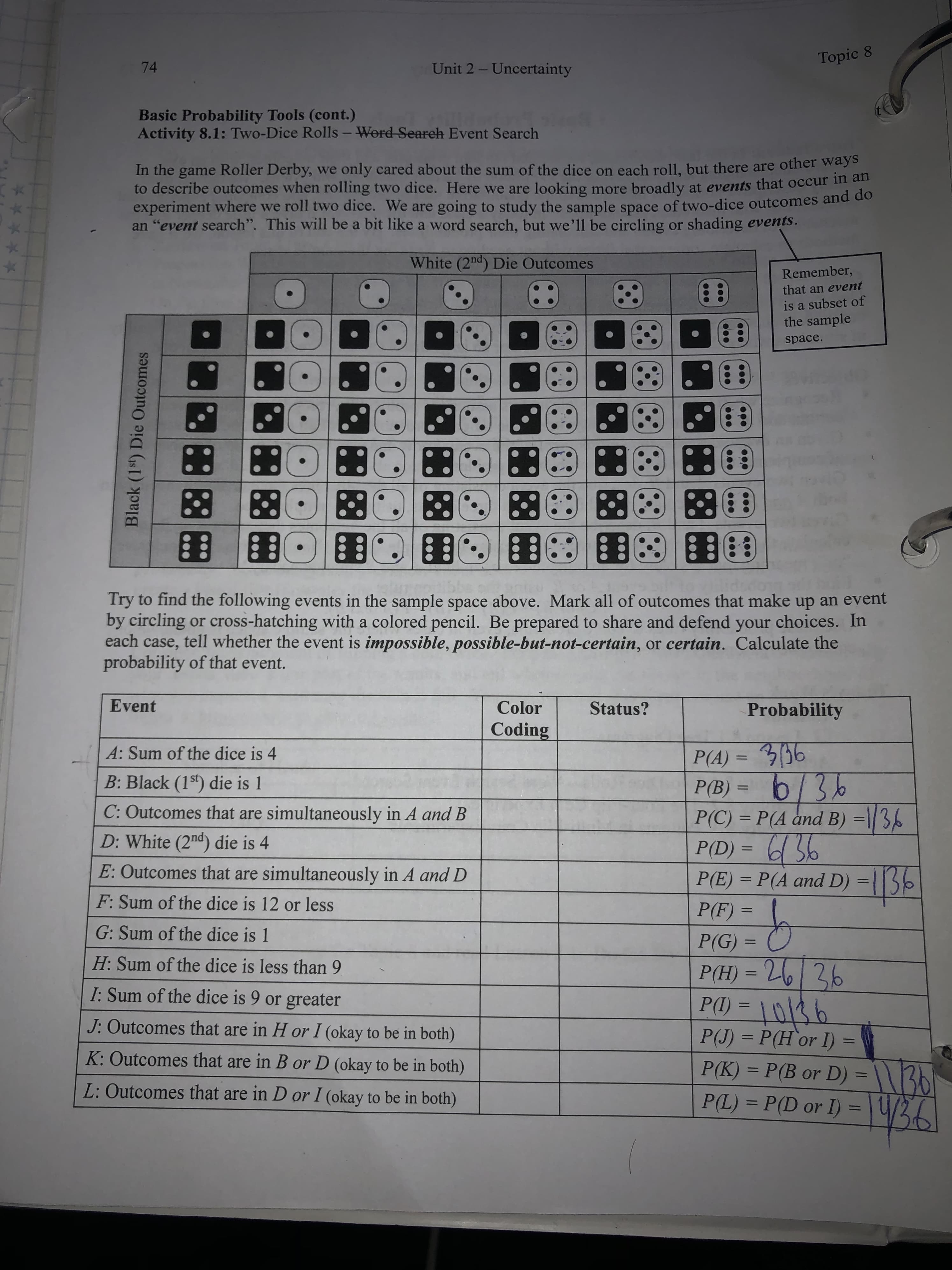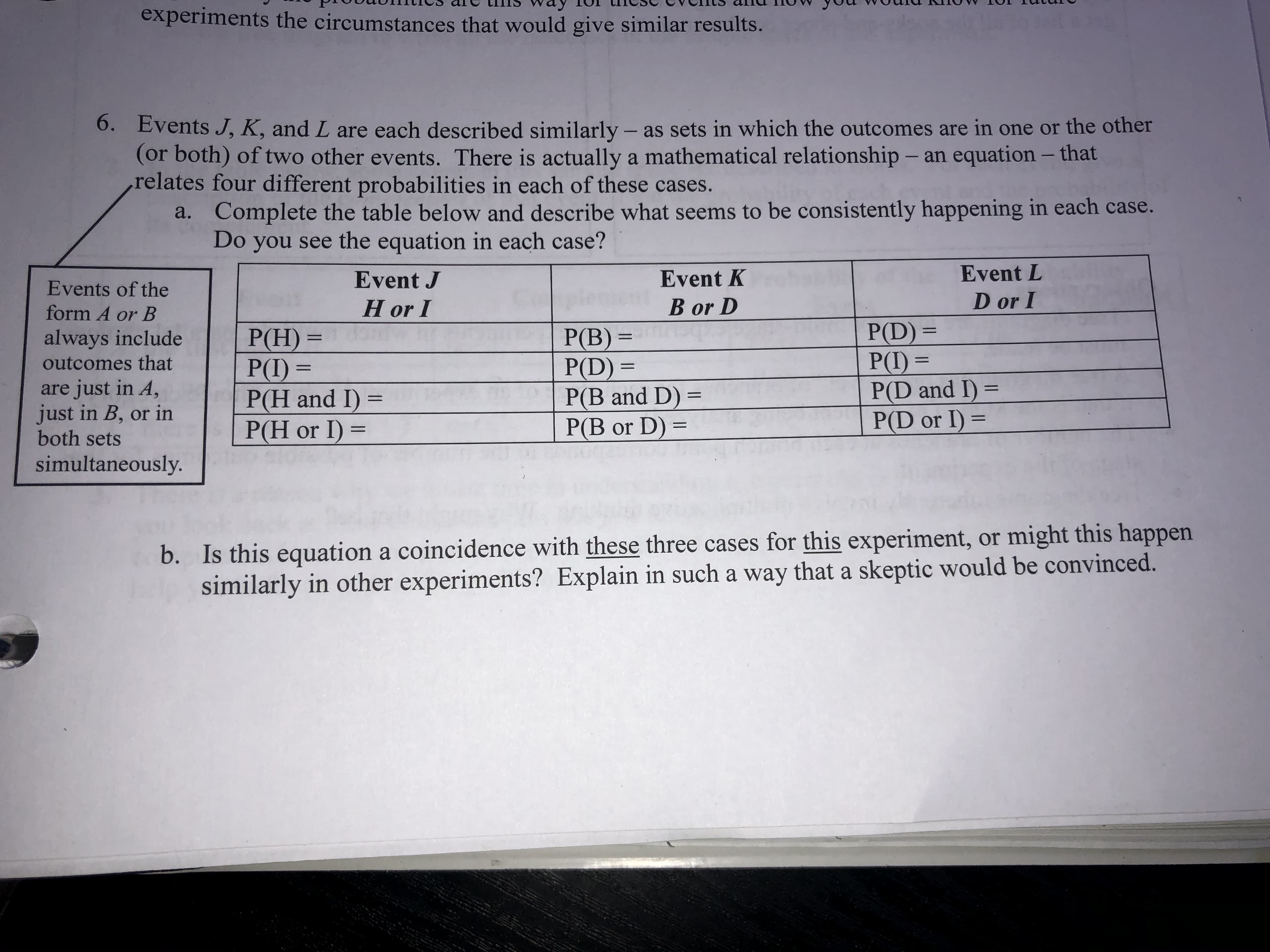Topic 8 Unit 2- Uncertainty 74 Basic Probability Tools (cont.) Activity 8.1: Two-Dice Rolls-Word Seareh Event Search In the game Roller Derby, we only cared about the sum of the dice on each roll, but there are other ways to describe outcomes when rolling two dice. Here we are looking more broadly at events that occur in an experiment where we roll two dice. We are going to study the sample space of two-dice outcomes and do an "event search". This will be a bit like a word search, but we'll be circling or shading events. White (2nd) Die Outcomes Remember, that an event is a subset of the sample space. Try to find the following events in the sample space above. Mark all of outcomes that make up an event by circling or cross-hatching with a colored pencil. Be prepared to share and defend your choices. In each case, tell whether the event is impossible, possible-but-not-certain, or certain. Calculate the probability of that event. Event Probability Color Status? Coding A: Sum of the dice is 4 P(A) = 6 B:Black (1st) die is 1 P(B)b/36 Р В) 11 C: Outcomes that are simultaneously in A and B P(C) = P(A and B) =|36 P(D)=6 P(E) = P(A and D) D:White (2nd) die is 4 E:Outcomes that are simultaneously in A and D F: Sum of the dice is 12 or less P(F) = G: Sum of the dice is 1 P(G) = H:Sum of the dice is less than 9 P(H) 26 36 1 I: Sum of the dice is 9 or greater PO=1036 P(J) = P(Hor I) = P(K) = P(B or D) = \\3b P(L) = P(D or I) = 6 J:Outcomes that are in H or I (okay to be in both) K: Outcomes that are in B or D (okay to be in both) 11 11 L:Outcomes that are in D or I (okay to be in both) 1 Black (1st) Die Outcomes .. experiments the circumstances that would give similar results. 6. Events J, K, and L are each described similarly - as sets in which the outcomes are in one or the other (or both) of two other events. There is actually a mathematical relationship - an equation - that ,relates four different probabilities in each of these cases. Complete the table below and describe what seems to be consistently happening in each case. Do you see the equation in each case? а. Event L Event K Event J Events of the D or I B or D Hor I form A or B P(D)= P(I)= P(D and I) = P(D or I) = P(B) P(D) = P(B and D)= P(B or D) = always include outcomes that P(H)= P(I)= P(H and I) P(H or I) = II 11 just in A, just in B, or in both sets are 1 simultaneously. might this happen Is this equation a coincidence with these three cases for this experiment, or similarly in other experiments? Explain in such a way that a skeptic would be convinced. b.
Topic 8 Unit 2- Uncertainty 74 Basic Probability Tools (cont.) Activity 8.1: Two-Dice Rolls-Word Seareh Event Search In the game Roller Derby, we only cared about the sum of the dice on each roll, but there are other ways to describe outcomes when rolling two dice. Here we are looking more broadly at events that occur in an experiment where we roll two dice. We are going to study the sample space of two-dice outcomes and do an "event search". This will be a bit like a word search, but we'll be circling or shading events. White (2nd) Die Outcomes Remember, that an event is a subset of the sample space. Try to find the following events in the sample space above. Mark all of outcomes that make up an event by circling or cross-hatching with a colored pencil. Be prepared to share and defend your choices. In each case, tell whether the event is impossible, possible-but-not-certain, or certain. Calculate the probability of that event. Event Probability Color Status? Coding A: Sum of the dice is 4 P(A) = 6 B:Black (1st) die is 1 P(B)b/36 Р В) 11 C: Outcomes that are simultaneously in A and B P(C) = P(A and B) =|36 P(D)=6 P(E) = P(A and D) D:White (2nd) die is 4 E:Outcomes that are simultaneously in A and D F: Sum of the dice is 12 or less P(F) = G: Sum of the dice is 1 P(G) = H:Sum of the dice is less than 9 P(H) 26 36 1 I: Sum of the dice is 9 or greater PO=1036 P(J) = P(Hor I) = P(K) = P(B or D) = \\3b P(L) = P(D or I) = 6 J:Outcomes that are in H or I (okay to be in both) K: Outcomes that are in B or D (okay to be in both) 11 11 L:Outcomes that are in D or I (okay to be in both) 1 Black (1st) Die Outcomes .. experiments the circumstances that would give similar results. 6. Events J, K, and L are each described similarly - as sets in which the outcomes are in one or the other (or both) of two other events. There is actually a mathematical relationship - an equation - that ,relates four different probabilities in each of these cases. Complete the table below and describe what seems to be consistently happening in each case. Do you see the equation in each case? а. Event L Event K Event J Events of the D or I B or D Hor I form A or B P(D)= P(I)= P(D and I) = P(D or I) = P(B) P(D) = P(B and D)= P(B or D) = always include outcomes that P(H)= P(I)= P(H and I) P(H or I) = II 11 just in A, just in B, or in both sets are 1 simultaneously. might this happen Is this equation a coincidence with these three cases for this experiment, or similarly in other experiments? Explain in such a way that a skeptic would be convinced. b.
Chapter8: Sequences, Series,and Probability
Section8.7: Probability
Problem 50E: Flexible Work Hours In a recent survey, people were asked whether they would prefer to work flexible...
Related questions
Topic Video
Question
100%
The real question is on the second picture. First one is just for reference. Thanks is advance!!

Transcribed Image Text:Topic 8
Unit 2- Uncertainty
74
Basic Probability Tools (cont.)
Activity 8.1: Two-Dice Rolls-Word Seareh Event Search
In the game Roller Derby, we only cared about the sum of the dice on each roll, but there are other ways
to describe outcomes when rolling two dice. Here we are looking more broadly at events that occur in an
experiment where we roll two dice. We are going to study the sample space of two-dice outcomes and do
an "event search". This will be a bit like a word search, but we'll be circling or shading events.
White (2nd) Die Outcomes
Remember,
that an event
is a subset of
the sample
space.
Try to find the following events in the sample space above. Mark all of outcomes that make up an event
by circling or cross-hatching with a colored pencil. Be prepared to share and defend your choices. In
each case, tell whether the event is impossible, possible-but-not-certain, or certain. Calculate the
probability of that event.
Event
Probability
Color
Status?
Coding
A: Sum of the dice is 4
P(A) = 6
B:Black (1st) die is 1
P(B)b/36
Р В)
11
C: Outcomes that are simultaneously in A and B
P(C) = P(A and B) =|36
P(D)=6
P(E) = P(A and D)
D:White (2nd) die is 4
E:Outcomes that are simultaneously in A and D
F: Sum of the dice is 12 or less
P(F) =
G: Sum of the dice is 1
P(G) =
H:Sum of the dice is less than 9
P(H) 26
36
1
I: Sum of the dice is 9 or greater
PO=1036
P(J) = P(Hor I) =
P(K) = P(B or D) = \\3b
P(L) = P(D or I) = 6
J:Outcomes that are in H or I (okay to be in both)
K: Outcomes that are in B or D (okay to be in both)
11
11
L:Outcomes that are in D or I (okay to be in both)
1
Black (1st) Die Outcomes
..

Transcribed Image Text:experiments the circumstances that would give similar results.
6. Events J, K, and L are each described similarly - as sets in which the outcomes are in one or the other
(or both) of two other events. There is actually a mathematical relationship - an equation - that
,relates four different probabilities in each of these cases.
Complete the table below and describe what seems to be consistently happening in each case.
Do you see the equation in each case?
а.
Event L
Event K
Event J
Events of the
D or I
B or D
Hor I
form A or B
P(D)=
P(I)=
P(D and I) =
P(D or I) =
P(B)
P(D) =
P(B and D)=
P(B or D) =
always include
outcomes that
P(H)=
P(I)=
P(H and I)
P(H or I) =
II
11
just in A,
just in B, or in
both sets
are
1
simultaneously.
might this happen
Is this equation a coincidence with these three cases for this experiment, or
similarly in other experiments? Explain in such a way that a skeptic would be convinced.
b.
Expert Solution
This question has been solved!
Explore an expertly crafted, step-by-step solution for a thorough understanding of key concepts.
This is a popular solution!
Trending now
This is a popular solution!
Step by step
Solved in 4 steps with 1 images

Knowledge Booster
Learn more about
Need a deep-dive on the concept behind this application? Look no further. Learn more about this topic, probability and related others by exploring similar questions and additional content below.Recommended textbooks for you


College Algebra
Algebra
ISBN:
9781305115545
Author:
James Stewart, Lothar Redlin, Saleem Watson
Publisher:
Cengage Learning


College Algebra
Algebra
ISBN:
9781305115545
Author:
James Stewart, Lothar Redlin, Saleem Watson
Publisher:
Cengage Learning